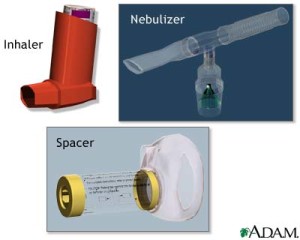Difference Between Inhaler and Nebulizer
The administration of medicines in respiratory disorders like asthma, COPD (chronic obstructive pulmonary disease) and Cystic Fibrosis by means of inhalation is common practice. Inhalers and nebulizers are the devices used to administer these medicines which may be relievers or preventers.
Difference in devices:
Inhalers, also called puffers, are small, handheld devices made of plastic and metal. They comprise of a pressurized tin canister containing the medicine solution which is released in fixed measured doses when the canister is pressed. Thus, they are also referred to as ‘metered dose inhalers’. These inhalers may be used with a plastic add-on device called a ‘spacer’ which is placed between the canister and the patient’s mouth to assist the inhalation of medicine. The other type of inhaler available is a DPI (dry powder inhaler) which uses a calculated dose of powdered medicine present in a conventional capsule requiring manual loading.
The nebulizer is a bulky device, a compressor, containing compressed air or oxygen that delivers the air through a tube to the mouthpiece. The compressed air or oxygen flows with high velocity through the tube and into the liquid medicine present within a small cup in the mouthpiece, converting it into mist for inhalation. Nebulizers are either electronic with plug-ins or battery operated. The most commonly used ones are jet nebulizers which are easy to use but make a loud vibratory sound when switched on.
Difference in mechanism:
Inhalers work by releasing the medicine in the form of aerosols that are inhaled through the mouth; the patient needs to co-ordinate his inhalation with the release of the medicine. The spacer device catches the aerosols released from the inhaler which can then be taken into the mouth via slow, deep breaths, 4 to 6 times. Following this, the patient needs to hold his breath for 10 seconds to allow the aerosols to settle over the bronchial walls.
Nebulizers convert liquid medicine into mist using pressurized air/oxygen which is then inhaled by the patient through a mask covering the nose, connected to the nebulizer. The medicine is poured into the cup attached to the mask and when the nebulizer is switched on, slowly the solution gets converted into mist for inhalation over a duration of 10 to 20 minutes.
Advantages and Disadvantages:
Inhalers are cheaper, quicker and can be easily carried by the patient everywhere. Being cost-effective they are prescribed for routine use in respiratory disorders. However, inhalers require co-ordination of breath to enable the medicine to reach the lungs which if not done properly, will result in poor breathing relief for the asthmatic. This has been addressed to a great extent by the spacer devices.
Nebulizers prove of advantage in hospitals when medications need to be administered to patients with a tracheostomy collar or who are intubated, those with severe breathing difficulty, in ambulances, etc. However, nebulizers are bulky, not easily portable and prove more expensive than inhalers. It is unfounded that a nebulizer is better than an inhaler. In fact, side effects like anxiety and tremors due to asthma medicines are seen to occur more when delivered through a nebulizer.
Summary:
Inhalers and nebulizers are both equally effective in the administration of the medicine. Inhalers are portable devices which when used with a spacer prove to be more efficient. Nebulizers are not portable and costlier as liquid medicine is more expensive so they are mostly used in hospitals. The device recommended by your doctor could be any one, what is important is to learn the appropriate way of using it so that the medicines administered reach the lungs completely to control your respiratory disorder.
- Difference between near sightedness and far sightedness - January 21, 2015
- Difference between Diverticulosis and Diverticulitis - January 20, 2015
- Difference between Prilosec and Nexium - January 19, 2015
Search DifferenceBetween.net :
3 Comments
Leave a Response
References :
[0]http://www.wakemed.org/adam/careguides/asthma/images/19370.jpg


As a life long asthmatic I’ve used both. Contrary to the idea that cheap is better; I personally disagree. I have a more difficult time getting my physiologically compromised lungs to inhale at the rate needed for deep delivery of the inhaler medication. On the other hand; I like the nebulizer. With my nebulizer I have never, at home or in the hospital used a facemask, only the mouth piece. I’m able to inhale more deeply, particularly after the first inhale. On 10/3/’14 I ordered my Omron Micro-Air Electronic Nebulizer…yes its $169; but, I can put it into my backpack and go hiking. I can take 2 inhale’s and put it away. The medication will stay useable throughout the day, then I’ll discard. Medication for me is delivered more effectively.
I have used my rescue inhaler up to 3X’s, 2-puffs each time in a mile walk and had no relief.
I’m not associated with any company…I’ve survived 4 major attaches by 7 yrs. and 1 at 22 yrs: I was hospitalized for all of these for 2 weeks.
Thank you that was so helpful.
w I have read some of their stories online before using their natural herbal formula , I had very hard time breathing then, and even more so at night, it was so bad I can’t sleep. I get up with a tight chest that feels blocked and can’t breathe well at all,I was excused from normal life responsibilities but natural herbs from multivitamincare org really helped a but sometimes I think is God prodigy that I was able to treat my Chronic obstructive pulmonary disease but multivitamin care herbal formula has a big impact on my recovery because my heart condition has been fully reversed . They do things for me, and was too happy to comply with their service. This is a equitable of a way to get of your COPD emphysema .